Constitution Class
Created by Fleet Admiral Luzol Targaryen on Thu Jul 13th, 2023 @ 1:25am
Constitution Class
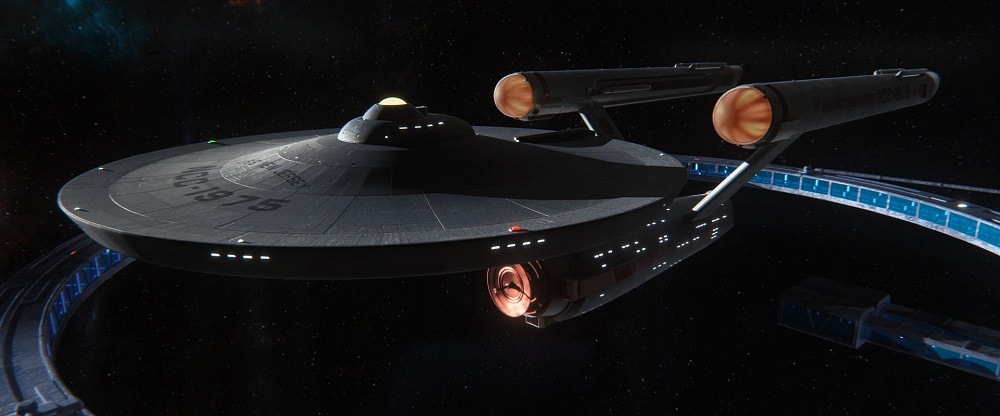 | |
| Affiliation: | Federation Starfleet |
| Service Period: | 23rd Century |
| Length: | 289 meters |
| Width: | 127 meters |
| Height: | 72 meters |
| Mass: | 600,000 metric tons |
| Decks: | 21 |
| Crew: | 433 personnel |
| Speed: | Warp 9 (Old Scale) |
| Armament: | Laser Banks (First Generation) Phase Cannons (First Generation) Phaser Banks (Second Generation and Refits) Torpedo Launchers |
| Defenses: | Deflector Shields |
| Auxiliary craft: | Starfleet Shuttlecraft |
Primary Shipyards
40 Eridani Ship Yards, Vulcan; San Francisco Orbital Shipyards, Earth; Tellar Consolidated Fleet Yards, Tellar Prime; Voloanti Slips, Andoria
Overview
During the early days of the United Federation of Planets and Starfleet, the Federation opted to upgrade the existing vessels of its member navies to serve the new organizational Starfleet. Because of this lack of innovation, vessel design within the Federation stagnated with only a few original concepts being produced during this new era. As time passed, and a limited number of vessels were produced, Starfleet Command realized that they would need a flagship class that could carry the Federation into the 23rd Century. A front-line exploration vessel, this new class would need to be self-sufficient and capable of long duration exploratory missions with limited outside support from the rest of Starfleet. With the expanding threat posed by the Klingon Empire and the unknown dangers that the crews of these ships would face, another priority would be that these ships would have to be able to withstand the test of time and stand toe to toe with the expanding Klingon Fleet.
In 2235 Commodore Matt Jefferies presented Starfleet Admiral Gene Roddenberry with the concept design for the Constitution Class Starship. Quickly approved, the first generation of the Constitution Class were produced at San Francisco Fleet Yards with future generations of the vessel being produced throughout the Federation's Core Worlds. Historians would look upon the Constitution Class as the symbol of Starfleet in the 23rd Century and all Starfleet exploratory vessels throughout history have been compared to this flagship vessel.
Capabilities
The design of the first generation Constitution Class vessel would become the standard of Federation shipbuilding with a saucer shaped primary hull containing the command and crew support systems while a cylindrical secondary hull would be home to the vessel's engines and deflector systems. Twin Warp Nacelles, placed away from the main body of the vessel atop pylons for the protection of the crew, were given a rugged design that could be easily repaired by crews in an emergency.
A technological marvel, cutting edge equipment was installed aboard the Constitution Class with more traditional systems installed on her sister design, the Sombra Class. Dr. Lawrence Marvick worked closely on designing engineering systems of the vessel, with the engines of the Constitution being able to operate beyond the routine safety limits and at higher field densities of similarly sized vessels. Another advancement of the design was the installation of Duotronic Computer Cores designed by Dr. Richard Daystrom and their SCARS operating system. Due to the presence of the Duotronic system, the Constitution would be better prepared to handle the demands of the mission profiles of the design and had sensor capabilities that were not surpassed until the 2290s.
Initially launched with Phase Cannons and Laser Banks, the Constitution would later be upgraded to support recently developed Phaser technology as the primary weapon of the design. Due to limitations on automation, Phaser Banks were manned by two crewmembers who had to manually target and fire upon enemy vessels. Photon Torpedoes were utilized as the secondary weapon of the Constitution Class design and were capable of firing in forward arcs from the vessel's saucer module. For protection of the Constitution Class a high capacity shielding system was installed based upon the work of the Andorian Empire.
As aforementioned the limited automation abilities of the class meant that large crews of up to 400 persons were assigned to the Constitution Class to meet the requirements of its duties with many personnel "crammed in" to meet demand. Crew accommodations were comfortable compared to similar designs of the era and the vessel included a large gymnasium, lounges, and mess halls for crew support. A large Shuttlebay was located along the aft portion of the engineering hull and storage compartments comprised most of the lower decks of this section.
Refits and Variants
Considered the pinnacle of construction in its era, the original 13 Constitution Class starships had minor differences in their construction depending on the government building the vessel. Ships produced at Andor featured additional Phaser Banks and engine components, while vessels produced at Earth had stronger hull plating and munitions storage. Tellarite produced ships had improved computer technology and ships originating at Vulcan had improved sensor technology compared to their peers.
Mission Profiles
Explorer, Scientific and Survey Operations, Strategic and Diplomatic Operations. Being appointed to a Constitution Class Starship assigned to a five-year mission is a highly sought after post within Starfleet.
Naming Conventions
The names of Constitution Class vessels have been taken from many different naming conventions from throughout the Federation, but the first generation of starships were named in honor of World War II naval vessels from Earth's history.
Notable Starships
U.S.S. Constitution, Class Prototype U.S.S. Constellation U.S.S. Enterprise U.S.S. Lexington U.S.S. Yorktown
Constitution II Class
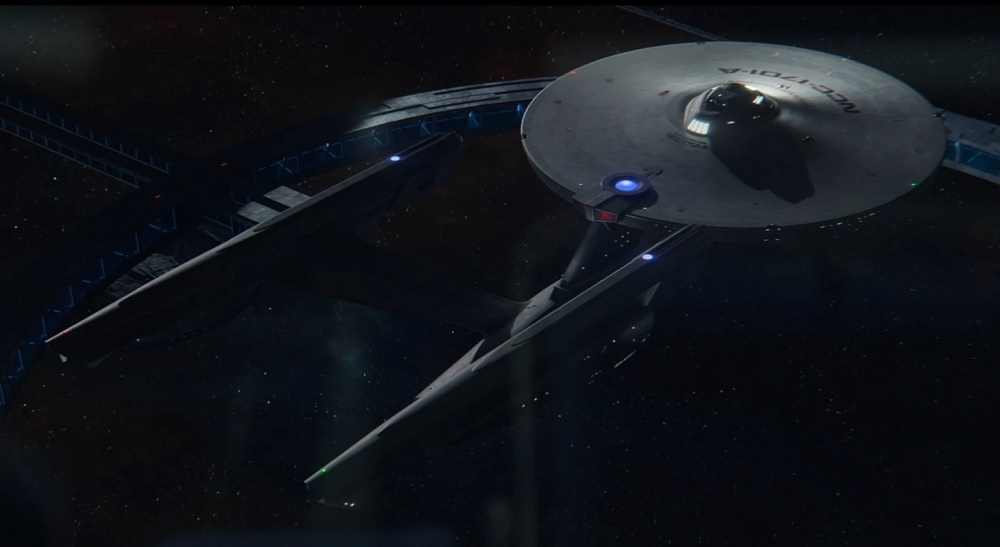 | |
| Affiliation: | Federation Starfleet |
| Service Period: | 23rd - 24th Centuries |
| Length: | 305 meters |
| Width: | 140 meters |
| Height: | 75 meters |
| Mass: | 620,000 metric tons |
| Decks: | 23 |
| Crew: | 400 personnel |
| Speed: | Warp 9.5 (Old Scale) |
| Armament: | Phaser Banks Torpedo Launchers |
| Defenses: | Deflector Shields |
| Auxiliary craft: | Starfleet Shuttlecraft |
Primary Shipyards
40 Eridani Ship Yards, Vulcan; San Francisco Orbital Shipyards, Earth; Tellar Consolidated Fleet Yards, Tellar Prime; Voloanti Slips, Andoria
Overview
The Constitution Class was the symbol of Starfleet in the 23rd Century and had become legendary throughout the Alpha and Beta Quadrant. Of all the Constitution Class vessels constructed, none were as storied as the famous U.S.S. Enterprise. One of the only Constitution Class vessels to successfully complete multiple five-year missions of exploration, the Enterprise and its crew were legends throughout Starfleet. The only problem was that the Enterprise and her sisters were getting older and were at risk of being outclassed by newer generations of Starfleet vessel.Based upon his experiences as Chief Engineer of the Enterprise, Lieutenant Commander Montgomery Scott presented a detailed proposal to the San Francisco Fleet Yard to revitalize the Enterprise to be comparable to the latest starships being launched from spacedock. Projected to last 18-months, the refit of the Enterprise would produce what was essentially an all new starship as both the exterior and interior of the ship would be upgraded to modern specifications. For most scholars the Constitution II is the best ship that the Federation has ever produced in its history.
Capabilities
The Constitution II Class maintained the same general appearance of its predecessor, only modernized with a sleeker look. Upgraded with new hull plating, the Constitution II has a saucer shaped primary hull and a cylindrical shaped engineering hull housing two upgraded warp nacelles. The new warp nacelles have modified warp coils that are nearly twice as efficient as those used on the original Enterprise, offering greater acceleration and handling at high warp velocities. Sublight propulsion is achieved through an enhanced Impulse Drive installed in the Saucer Module of the ship. The new Constitution II would have incredible acceleration abilities compared to its predecessor thanks to the installation of an impulse deflection system that transfers energy from the Warp Core to the Impulse Drive.
The Starfleet Tactical Operations Group worked closely on the development of the Constitution II to improve the vessel's tactical profile due to enhancements being made to the vessels of the Klingon and Romulan Fleets. Previously the Constitution Class employed Phaser Capacitors to power the Phaser weaponry of the vessel, but the new Constitution II would have Phaser power supplied directly from the Warp Core itself to increase firepower and rate of fire. With the installation of new sensor equipment the Torpedo Launchers were moved from the Primary Hull to the Secondary Hull, allowing for an enhanced rate of fire compared to the previous model.
Knowing that the ships of the Constitution II would be away from their homes for five-year missions, Starfleet Command directed that accommodations on the new Constitution be enhanced from previous generations to be more comfortable for long-term voyages. Additional recreation spaces were installed and a large arboretum, which assisted the life support equipment, offered crew a chance to unwind. The Cargo and Shuttle Bays of the Constitution II were expanded from the previous design allowing for more secondary craft and cargo to be transported by the Constitution II.
Refits and Variants
While considered a newer design in the late 23rd Century, the Constitution II was already showing its age at the dawn of the 24th Century and was being quickly outpaced by successor designs. Starfleet Command launched several refit programs to keep the Constitution II viable by enhancing its energy generation and warp capability, but in many ways the design was a victim of its own success and grew out of favor for its inability to keep apace with technological improvements.
Mission Profiles
Explorer, Scientific and Survey Operations, Strategic and Diplomatic Operations. Despite the emergence of newer designs inspired by the Excelsior Class, the Constitution II is a highly sought after posting due to its history within the Federation.
Naming Conventions
The names of Constitution Class vessels have been taken from different naming conventions from throughout the Federation, but vessels are commonly named for historic seafaring vessels and starships.
Notable Starships
U.S.S. Enterprise, Class Prototype U.S.S. Eagle U.S.S. Endeavour U.S.S. Enterprise-A U.S.S. Potemkin
Constitution III Class
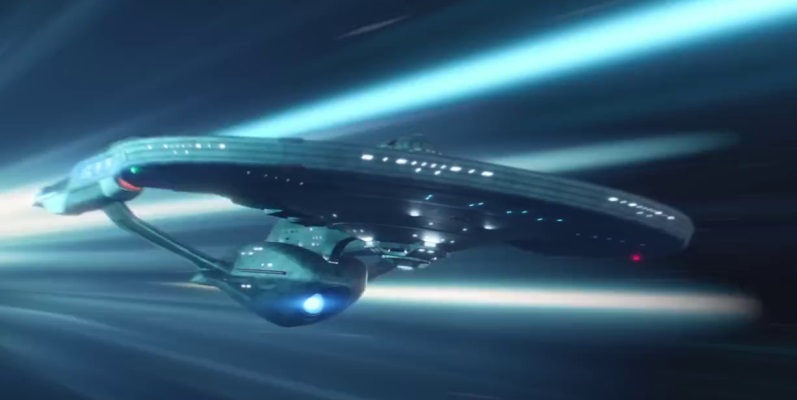 | |
| Affiliation: | Federation Starfleet |
| Service Period: | 25th - 26th Centuries |
| Length: | 560 meters |
| Width: | 257 meters |
| Height: | 95 meters |
| Mass: | 1,139,705 metric tons |
| Decks: | 28 |
| Crew: | 500 personnel |
| Speed: | Warp 9.99 |
| Armament: | Phaser Arrays Phaser Banks Torpedo Launchers |
| Defenses: | Metaphasic Shields |
| Auxiliary craft: | Starfleet Shuttlecraft |
Primary Shipyards
Copernicus Ship Yards, Luna; Lagrange Slips, Denobula; San Francisco Orbital Ship Yards, Earth
Overview
While the governments of the Khitomer Alliance were considered the victors of the Dominion War, no nation truly went unscathed. While many members of Starfleet Command wanted to focus on building larger, multifaceted craft to make up for Starfleet’s losses, Starfleet’s depletion from the Dominion War was more serious than any wanted to admit. This, coupled with the needs of the Romulan Relocation Effort, led the Starfleet Corps of Engineers to focus on producing smaller vessels to compensate for limited resources and a war weary pool of trained personnel. Later, after the attack upon the Utopia Planitia Fleet Yards in 2385, the Federation Council called upon Starfleet to build a symbol to remind the galaxy of the traditions that made the Federation great as their next flagship vessel.
Now headquartered at the San Francisco Orbital Shipyards on Earth, the Engineering Corps looked to Starfleet's past to build its future. Heir to the legacy of the Constitution Class, the Constitution III Class (or Neo-Constitution Class) was designed to be the new workhorse of the fleet, conducting exploratory missions and supporting fleet operations when needed. Featuring an accelerated development timeline, many of the earliest Neo-Constitutions were built by recycling components from decommissioned or scrapped vessels to build new spacecraft. Despite its advancements, the Constitution III lacks the advanced scientific capabilities and the firepower of its predecessors.
Capabilities
The Constitution III Class follows the traditional lines of its 23rd Century predecessors, closely replicating the design of the Constitution II and the Shangri-La Classes. The vessel features a saucer shaped primary hull and a cylindrical engineering section that feeds twin warp nacelles similar to those of the Sagan Class. The most striking feature of the Constitution III Class is its enhanced, albeit overpowered, Impulse Engines – which have been designed to cater to a close support envelope at sublight speeds. This modification allows the Constitution III to have improved handling in and around densely populated solar systems and provides members of this class with the highest sublight power to geometry ratio in Starfleet history. Sporting a new dilithium chamber capable of keeping the crystals stable at high warp speeds for longer periods of time, the Constitution III is one of the fastest vessels in Starfleet and can maintain a stable velocity of Warp 9.99.
Outfitted with metaphasic shielding, the Constitution III's primary weapons are Narrow-Angle Phaser Beam Arrays, which sacrifice some of their fire arc in exchange for a stronger punch. An enhanced electro-plasma distribution network allows ships of the Constitution III Class to run equipment with high energy demands, like industrial replicators, with little loss on overall efficiency. Further, the Constitution III features three shuttlebays and expansive cargo holds. These features, coupled with its speed, make the Constitution III ideal for mercy missions or emergency response.
Refits and Variants
Through its lifetime two separate refit programs were implemented in an effort to improve the longevity of the Constitution III Class. The first generation of refits were designed to improve the vessel’s weapon systems after several members of the class were overwhelmed during encounters with more technologically sophisticated and hostile species. A second refit attempted to overcome the Constitution III’s deficits with scientific exploration, leading to portions of the Saucer Module to be reconfigured to house additional sensor equipment and laboratories at the expense of the already limited defensive suite.
Mission Profiles
Crisis and Emergency Response, Pathfinder and Reconnaissance Operations, Scientific and Survey Operations. Vessels of the Constitution III Class are highly sought after postings due to the legacy of the Constitution Class vessels that came before and their return to five-year missions.
Naming Conventions
Members of the Constitution III Class have names taken from many different naming conventions from throughout the Federation, but are commonly named after historic Federation vessels.
Notable Starships
U.S.S. Constitution, Class Prototype U.S.S. Enterprise-G (U.S.S. Titan-A) U.S.S. Excalibur-B U.S.S. Exeter U.S.S. Intrepid U.S.S. Lexington
Constitution V Class
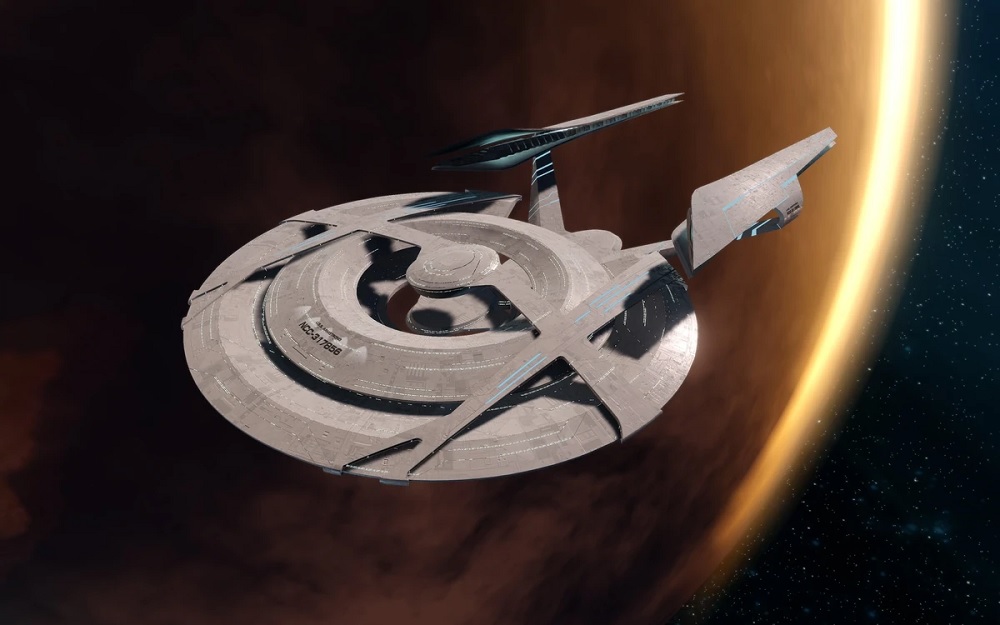 | |
| Affiliation: | Federation Starfleet |
| Service Period: | 31st - 32nd Centuries |
| Length: | 1,399 meters |
| Width: | 615 meters |
| Height: | 348 meters |
| Mass: | 2,904,000 metric tons |
| Decks: | 100 |
| Crew: | 2,000 personnel |
| Speed: | Warp 9.995 |
| Armament: | Phaser Banks Torpedo Launchers |
| Defenses: | Cloaking Device Regenerative Shields |
| Auxiliary craft: | Starfleet Shuttlecraft |
Primary Shipyards
Mizar Fleetyards, Mizar; San Francisco Orbital Shipyards, Earth; Tellar Consolidated Fleet Yards, Tellar Prime;
Overview
For generations the worlds of the United Federation of Planets lived in relative peace and, at its height, the Federation consisted of over 350 member worlds spread throughout the Milky Way Galaxy. During this period of peace, Starfleet returned to its idealistic roots and served as the Federation's exploratory, humanitarian, and peacekeeping armada throughout the galaxy. Aside from the Temporal Cold War and a few minor skirmishes, Starfleet was unchallenged except for the emergence of an unexpected threat in the form of dilithium becoming scarce throughout the galaxy. As the Federation worked on finding new sources of this vital element, Starfleet looked to its past to find hope for the future.
Designed to serve as the new flagship of the Federation, the Constitution V Class was immediately ordered by the Federation Council to bring hope to a weary galaxy. As ordered the Constitution V would have to be capable of performing long-range, deep-space exploration and frontier support with next to no support from the rest of Starfleet. This design brief would necessitate the inclusion of a high crew capacity, systemic redundancies to protect the ship from harm, and tactical capabilities that could enable the ship to survive confrontations with heavily armed opponents. With the first generation quickly launched from San Francisco Orbital Shipyards, the Constitution V would become a symbol for the Federation and Starfleet following the devastating disaster known as the Burn. With few vessels left, the Constitution V would find itself serving for over a century as the lead ship of Starfleet as the Federation struggled to survive.
Capabilities
The Constitution V Class Starship follows the time honored configuration of the Constitution Class, only the new design is a product of generations of innovation and experimentation and was over four times the size of the first Constitution Class vessel. A large, saucer shaped primary hull makes up the bulk of the craft and the vessel's nameplate adorns the dorsal surface. Segmented support beams run across the structure of the saucer module and the Bridge remains in a raised portion in the center of this module. A small, slender secondary hull houses the primary engines of the Constitution V and houses the ship's pair of Warp Nacelles. Unlike contemporary vessels, the Warp Nacelles of the Constitution V remain connected to the pylon structure at all times; however, the primary and secondary hulls of the vessel are connected through magnetic seals established by superconductors.
Like its predecessors, Constitution V Class ships are designed to be incredibly durable with many redundant technologies available that can survive the challenges that the galaxy has to offer. Starfleet protocol requires backup systems to be available for emergency situations and the Constitution V features redundancies for every major system aboard. With their durable construction, vessels of the Constitution V Class have easy access to shipboard systems and the super structure to allow for quick repairs.
The Constitution V was designed to complete a variety of mission profiles and has enhanced sensor and laboratory complexes available to it. The Constitution V's top of the line sensor pallets and telescopes can conduct high resolution scans of nearby phenomenon and can even be used for temporal analysis and manipulation through the Interstitial Multivector TransComputronics (IMT-C and often pronounced ihm-tech) software installed. This software generates brief closed time-like curves that provide probable outcomes in nanoseconds, allowing the Constitution V to assist in monitoring the timeline for temporal incursions. Protected by Regenerative Shielding, Constitution V Class starships are well armed with both Phasers and Torpedoes and incorporate a standard issue Starfleet Cloaking Device for added protection.
Refits and Variants
Starfleet Command had no opportunity to launch a formal refit program for the Constitution V Class vessel prior to the Burn. At least one vessel of the class was able to be refitted to test the SB-19 Project (an experimental propulsion system capable of transporting a vessel across thousands of light years in an instant); however, no additional vessels were produced with this modification following the Confederacy of Vulcan leaving the Federation.
Mission Profiles
Crisis and Emergency Response, Pathfinder and Reconnaissance Operations, Strategic and Diplomatic Missions. Initially designed as exploratory vessels, Constitution V Class Starships are rugged vessels designed to represent the very best the Federation has to offer to the Post-Burn galaxy.
Naming Conventions
The flagship class of Starfleet in the Pre and Post Burn galaxy, vessels of the Constitution V Class are frequently named after historic vessels from the Federation's past.
Notable Starships
U.S.S. James T. Kirk, Class Prototype U.S.S. Armstrong U.S.S. Bonhomme Richard U.S.S. Excalibur-M U.S.S. Noble
Constitution Class (Kelvin Timeline)
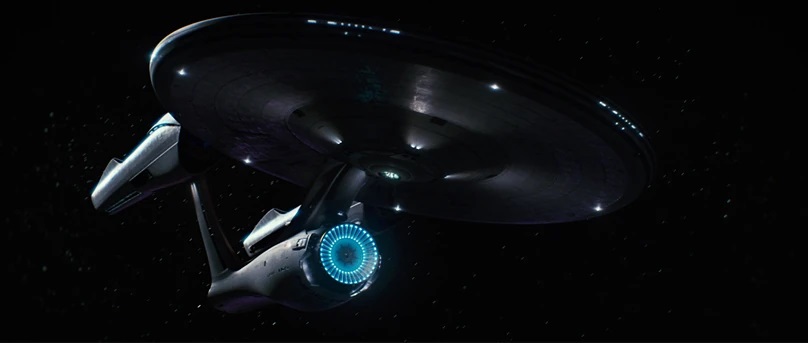 | |
| Affiliation: | Federation Starfleet |
| Service Period: | 23rd Century |
| Length: | 762 meters |
| Width: | 335 meters |
| Height: | 190 meters |
| Mass: | 495,000 metric tons |
| Decks: | 54 |
| Crew: | 1,100 personnel |
| Speed: | Warp 8 (Old Scale) |
| Armament: | Phaser Banks Torpedo Launchers |
| Defenses: | Deflector Shields |
| Auxiliary craft: | Starfleet Shuttlecraft |
Primary Shipyards
Riverside Ship Yards, Earth; Starbase Yorktown
Overview
On Stardate 2233.04 the U.S.S. Kelvin was on a scientific survey mission along the Federation/Klingon Border when it encountered a previously uncharted Black Hole. Beginning an investigation, the Kelvin was almost immediately attacked by a Romulan starship known as the Narada that emerged from the Black Hole. Heavily outgunned, the Kelvin was quickly disabled and its Captain, Richard Robau, was killed by the Romulan Commander. With few options left, Acting Captain George Kirk launched a suicide run against the Narada, using the evacuated Kelvin to inflict severe damage against the Romulan vessel. Unfortunately, Kirk was killed and the Narada was only disabled.
Fearing a technologically superior Romulan Star Empire as an enemy of the Federation, Starfleet Command ordered immediate work on a new front-line exploration vessel capable of being self-sufficient and undertaking long-term exploratory missions. With Starfleet shipbuilding having been long stagnant, the Riverside Shipyards were constructed to oversee development of the first generation Constitution Class starships. Overseen by Commodore Matt Jeffries, when completed the Constitution Class would become the symbol of Starfleet in the 23rd Century.
Capabilities
Physically, the Constitution Class was a groundbreaking design that featured a large saucer shaped primary hull and a conical engineering hull that supported twin warp nacelles. Externally, the hull of the Constitution Class had a subtle Aztec pattern consisting of iridescent plates and a more organic physical arrangement than prior generations of starship. Internally, the saucer section was designed to be aesthetically pleasing to the crew of the ship and contained the command and controls systems along with the primary crew support areas. The secondary hull, containing the engines, shuttlebays, and storage compartments featured more open space and an industrial look. In an emergency the primary and secondary hulls could be separated.
Using technology reversed engineered from scans taken by the Kelvin, the Constitution Class incorporates six phaser banks with twin phaser turrets installed. Capable of firing in beam or pulse configurations, the Constitution Class could use their phasers to attack a target or be set for point defense to defend the ship. Rapid fire torpedo launchers were designed for use by the Constitution Class and Photon Torpedoes, based upon those of the Narada, were installed. Divided into forward and aft deflector shields, the Constitution Class was defended by Metaphysic Shields with shield integrity monitored by the Diburnium-Osmium levels of the deflector grid. While at warp, the deflector dish would open and close depending on travel speed.
Regulated by the Bridge, sublight propulsion for the Constitution Class is provided by an Impulse Drive located along the aft section of the Saucer Module. Faster-than-light speeds are made available by the vessel's Warp Drive. Initially consisting of multiple reactors, the Constitution's Warp Drive was the most advanced in the fleet and operated by transferring energy from the intermix chamber to the twin nacelles. Due to its capabilities, Constitution Class ships had the best sensors in Starfleet and were capable of navigational maneuvers impossible for other ships.
The ability of the crew to survive in a catastrophic emergency is a priority of the Constitution Class. A large Med Bay capable of treating up to a dozen patients has been installed and is supported by a myriad of medical and science laboratories. Transporters offered quick entry and egress from the Constitution Class, but the target could not move prior to being dematerialized. A shuttlebay and multiple flight decks comprised a large portion of the drive section and multiple escape pods ensured every crewmember had a chance to escape should the vessel order to be abandoned. One of the innovations on the Constitution was the inclusion of the new Kelvin Pods, single person escape pods adjacent to the Bridge to allow the Senior Staff the chance to evacuate at the last moment.
Refits and Variants
Despite its relative youth, two successful refits have been implemented for the Constitution Class in its lifetime. The first refit was designed to enhance the vessel's warp profile, increasing the distance between the warp nacelles and inclining the warp pylons to increase the nacelle's distance to the primary hull. The vessel's multiple warp cores were replaced by a larger, single unit. While this refit was successful in increasing the stability of the warp field (and thus the vessel's speed), the loss of the Starship Enterprise revealed that these modifications could allow an enemy to overwhelm and disable the vessel quickly by targeting key structural points in the nacelle structure. This led to a second refit that allowed the vessel to maintain structural integrity longer if these points were attacked by increasing the armor in this region and the dorsal connection. Additional Phaser Emplacements were designed for this upgrade.
Mission Profiles
Explorer, Scientific and Survey Operations, Strategic and Diplomatic Operations. Surpassed only by the Dreadnought Class in technical ability, service on a Constitution Class ship is reserved for the best of the best that Starfleet has to offer.
Naming Conventions
The names of Constitution Class vessels have been taken from many different naming conventions from throughout the Federation, but the first generation of starships were named in honor of World War II naval vessels from Earth's history.
Notable Starships
U.S.S. Constitution, Class Prototype U.S.S. Constellation U.S.S. Enterprise U.S.S. Enterprise-A U.S.S. YorktownCategories: No categories found